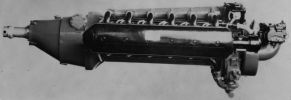
Continental XO-1430. Left View
U.S. Military Aircraft Engine Development, 1935 – 1947
Compiled by Kimble D. McCutcheon
Published 9 Apr 2024; Revised 12 Apr 2024
4 Feb 1936
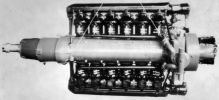 |
| Continental XO-1430, Bottom View |
In a letter from U.S. Army Air Corps Materiel Command (hereinafter MatCmd) Engineering Section Chief Lt Col O.P. Echols to the Chief of the Air Corps, Washington, DC, Col Echols related a 29 Jan 1936 telephone conversation with U.S. Navy Bureau of Aeronautics (hereinafter BuAer) Capt Stace concerning the Continental XO-1430-1. The liquid-cooled, 1,000 hp, 1,200 lb Continental XO-1430-1 was expected to be on test before 1 Mar 1936. These engines were particularly adapted for installation within the wing. Single-engine studies had been accomplished. The entire aft accessory section and supercharger were featured a single drive that reversed in a simple manner, which took care of oil pumps, coolant pumps, vacuum pumps, magnetos, and fuel injector drives. The left and right cams were identical, and in one case the camshafts were identical. Right and left rocker arms were used for the two cylinder banks; in the other bank, they were identical to the first bank, but one camshaft had the intake cams nearer the drive end while the other had the exhaust cams nearer the drive end. Engine direction reversal was accomplished either by moving the rockers from each bank to the other, or by interchanging the camshafts. The distributor utilized right and left fingers; the starting booster connection could be moved from one bank to the other, or the fingers could be interchanged. The direction conversion could be accomplished in two to three hours, without requiring any additional parts. The firing order was exactly reversed, and since the distributors rotated oppositely in left- or right-rotating engines, no ignition wire change was required other than the previously-mentioned starting booster connection. Fuel injection timing could be switched by rotating the fuel injection unit 180° and moving its control to the opposite side, all of which reversed the injection order. No plans existed for engine rotation conversion unless a shortage emerged. These rotation changes might have become necessary if the propeller wash from either engine aided in maintain flying stability in an engine-out condition. In normal flight, no airframe rigging was required to counteract torque. MatCmd and Continental thought it vital that all parts necessary to achieve engine reversal be present in every engine, and without sacrificing weight.
22 Sep 1936
Engineering Section Acting Chief Maj F.O. Carroll reported Continental and Lycoming high-speed opposed engine development status to the Dayton Inspector of Naval Aircraft (INA).
The Continental XO-1430-1 engine, with its 5.500" (139.70 mm) bore, 5.000" (127.00 mm) stroke, 1,425.50 in³ (23.360 l) displacement and 1,000 hp normal rating at had hopes for at least a 1,100 hp takeoff rating. It weighed about 1,600 lb (725.7 kg). It had been assembled and was being run-in and calibrated prior to a 50-hr development test at the Continental plant. All required single-cylinder testing was complete, but some additional single cylinder piston and piston ring testing was being conducted in hopes of eliminating the need to pin the piston rings against rotation (At that time, engineers worried that piston ring gap alignment would lead to excessive blow-by, a notion that was later dispelled when it was discovered that the rings naturally rotated at different rates and that the gaps were rarely aligned). The engine had produced 891 hp at 3,000 rpm. Although minor failures had been encountered, the XO-1430-1 was expected to be ready for the 50-hr development test in the near future. Additional parts had been procured in order to reduce repair time in case of failures during development testing.
t.jpg) |
t.jpg) |
t.jpg) |
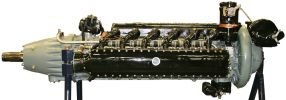 |
| Lycoming O-1230-1, Photographed at NEAM, 8 Apr 2006 | Lycoming O-1230-1, Restored, Left View | ||
The Lycoming XO-1230-1, with its 5.250" (133.35 mm) bore, 4.750" (120.65 mm) stroke and 1,233.91 in³ (20.220 l) displacement, was being fabricated and completion was expected about 1 Nov 1936. Required single-cylinder testing was complete, but additional two-cylinder blade-and-fork connecting rod testing was ongoing. The engine was normal-rated at 1,000 hp with hopes for at least a 1,100 hp takeoff rating. It weighed about 1,600 lb (725.7 kg). It was being prepared for a 50-hr development test. Lycoming was building three parts sets to expedite development testing.
Air Corps estimated that the XO-1430-1 would be ready for development testing by 31 Oct 1936 and that the XO-1230-1 would begin development testing about 31 Jan 1937. Type tests of both engines would be required after successful 50-hr test completion. Engine mount dimensions and attach points for both engines had been standardized, making them interchangeable in a given airframe. Both engines were shaped to facilitate very neat buried-wing installation; both engines had geared superchargers to achieve ground ratings; turbosuperchargers were intended to achieve altitude ratings. Air Corps believed that water and oil radiators could be installed in a way that offered very little parasitic drag, and that individual cylinder construction, which characterized both engines, was a necessity for high-temperature liquid cooling, plus the individual cylinders made maintenance easier. [Note: This philosophy of turbosupercharging, buried engines, high-temperature cooling and separate cylinders drove Air Corps engine development throughout the 1930s. None of the four pillars upon which this philosophy was based would pan out: turbosuperchargers required exotic alloys that had limited wartime availability; buried engines caused trouble for airframers' wing structure, landing gear and fuel tank placement; high-temperature cooling did not substantially reduce cooling drag, and no liquid-cooled separate-cylinder engine saw WWII service.]
Both engines facilitated relatively easy direction reversal for opposite-rotation multi-engine installation. The Lycoming engine was being fitted with fuel injection from the start, while the Continental was at first to be equipped with a four-barrel carburetor and converted to fuel injection later. Neither engine featured an aftercooler. The XO-1430-1 had a 2:1 propeller reduction gear ratio and a 3,000 rpm normal speed. The XO-1230-1 had a 2.5:1 propeller reduction gear ratio and a 3,100 rpm normal speed.
24 Nov 1936
The Air Corps and Navy agreed to keep one another informed about R-2600 and R-3350 testing progress. [22 Dec 1936 Letter, from the BuAer Chief to the Dayton, Ohio INA.]
11 Feb 1937
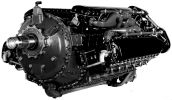 |
| Allison V-3420 |
Dayton INA B.J. Connell wrote the BuAer Chief, relating contemplated Air Corps 2,000 hp liquid-cooled engine. The Air Corps was negotiating with Allison Engineering Company to develop a Prestone (ethylene glycol) cooled engine that was substantially two Allison V-1710 V-12 engines geared together to drive a common propeller (hereinafter V-3420). Layout drawings had been produced and a contract was being prepared. The Air Corps was also discussing a liquid-cooled 1,800 hp engine (X-1800, aka XH-2600) with Pratt & Whitney Aircraft (P&WA), trying to convince P&WA that 2,000 hp would be the minimum useful size. The Air Corps stated it would be pleased to have the Navy work with P&WA to develop a 2,000 hp engine. A doubled Lycoming O-1230 (XH-2470) was also being discussed, but no action was contemplated until the 50-hr O-1230 test was complete. Power Plant Laboratory Chief Maj Page planned to visit the BuAer Power Plant Section within the next month and offered to furnish further specific information if desired.
MatCmd expected the first R-3350 to be delivered on 5 Apr 1937. If its testing was satisfactory, another seven engines were to be procured, and the Navy would be advised accordingly so it could purchase its engines simultaneously. At that time, the R-3350 under test at WAC had produced 1,500 hp. The Air Corps asked Navy to make available any plans for 2,000 hp liquid-cooled engine development.
19 Feb 1937
Navy BuAer Chief Rear Adm A.B. Cook answered the Dayton INA's 11 Feb 1937 letter. The Allison V-3420 was of interest to the Navy. P&WA had recently submitted to the Navy a preliminary study for a 3,130 in³ with a 2,000 hp normal rating and 2,300 hp takeoff rating. While Navy was concerned that the level of effort required to develop such an engine would prevent P&WA from bidding on engines larger that its current twin-row R-2180, it nonetheless invited P&WA to submit an informal quotation for an X-3130 development program. BuAer had always intended to invite the Air Corps to cooperate in 2,000 hp engine development, but suggested that Air Corps proceed with V-3420 development while Navy pursued X-3130 development. The Navy only had enough 1937 funds for preliminary design and single-cylinder or single-bank testing. Navy opined it beneficial to both services to secure two supply sources for essentially competing engines, and to share development costs for auxiliary equipment development, such as radiators, propellers, and turbosuperchargers.
On 23 Feb 1937, Navy Capt S.M. Kraus advised the Dayton INA that requisition 318-37 for two WAC XR-1820-28 for use in a test program had been issued, along with requisition 400-37 covering WAC XR-2600-2 in a Douglas XT3D-2 for flight testing. Navy was interested in the WAC XR-3350 50-hr test program and whether an Air Corps specification for the additional seven engines had been finalized. The Navy had no aircraft suitable for flight testing such a large engine; Air Corps wanted a three-engine test bed with the experimental engine in the center position and the outboard engines serving as safety backups.
In other correspondence dated 23 Feb 1937, Dayton INA B.J. Connell asked the Air Corps Engineering Section Chief if the Air Corps would prefer to have the Navy undertake all of the 2,000 hp P&WA liquid-cooled engine development. On 3 Mar 1937, Engineering Section Acting Chief Maj F.O. Carroll related to the Dayton INA that the plan for Navy to develop the 2,000 hp 24-cylinder P&WA liquid-cooled engine while the Air Corps pursued development of the 24-cylinder Allison XV-3420 liquid-cooled engine was satisfactory. This engine had a 2,000 hp normal rating and a 2,300 hp takeoff rating. It was scheduled to start test stand running in December 1937.
On 27 Oct 1938
MatCmd Executive Col Frank M. Kennedy wrote Air Corps Assistant Chief Brig Gen W.C. Kilner, listing make, model and takeoff rating for engines of more than 600 hp that were then in service or in development.
As new and more powerful engines were developed, their higher bmep values made the addition of exhaust turbines geared to crankshaft (compounding) attractive. MatCmd was building a compounded test engine to explore this concept.
The Chandler-Graves and Stromberg Injection carburetors were both satisfactory at that time from the perspective of ice formation. However, neither carburetor's metering was satisfactory, and ongoing development was hoped to improve the situation. Although satisfactory experimental fuel injection equipment had been tested, trouble had been encountered with further development and manufacturing. The subject company's contracts had been terminated and another was producing more satisfactory results. It was hoped that a fuel-injection equipped engine would soon become available for dynamometer and flight tests.
Engineers believed that great potential existed with the incorporation of fan cooling. Blower intake ducts would extend from the wing leading edge to an engine-driven fan, which, after flowing past the engine cylinders, would exit near the wing trailing edge. Tests had been conducted demonstrating that installed drag for such an installation would be in a maximum of 2% crankshaft power range. The best possible liquid-cooled installation was in the 4.5% range. It was believed that such an installation would be only marginally vulnerable, as bullet holes from machine gun bursts would result in air leaks that could be mitigated by slight engine power reduction. Conversely, battle damage to liquid-cooled installation would result in coolant loss and potential engine failure.
Planners believed that considerable supercharger improvement could be obtained through the incorporation of multi-speed and multi-stage geared superchargers, along with improved supercharger stage efficiency.
Engineers were working on diesel cycle modifications involving special fuels that could potentially improve engine efficiency.
On 12 Jan 1939
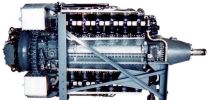 |
| P&WA X-1800 |
Air Corps Aircraft Branch Chief Maj Carl F. Greene notified the Air Corps Engineering Section Chief that the Aircraft Branch had recently indirectly discovered the large liquid-cooled engine development under consideration between MatCmd and P&WA. Since this class of engine would require intimate airframe integration, and would govern many aircraft design features, long-range development plans should be undertaken with Aircraft Branch cooperation. Aircraft Branch insisted that any proposed new engine arrangements be referred for study and analysis so that new engine developments, such as the P&WA X-1800, could take advantage of Aircraft Branch facilities that would define the military characteristics of future aircraft.
On 29 Jun 1939
Air Corps civilian employee Opie Chenoweth issued Memorandum 50-339, "Suggested Plans for Obtaining Engines Specifically for Military Applications." There, he noted that unlike European engines, American engines were unable to deliver the short-time military ratings and also pass the 150-hr type and model tests at that same rating; further, if these high-output engines were consigned to general peace-time usage, their short time between overhaul period would disrupt the existing Depot shop facilities. He concluded that a special fuel was necessary and suggested derating engines of extremely high output and subjecting them to standard 150-hr test using 100 PN fuel. If a national emergency arose, revised operating instructions and improved fuels would be supplied to the service and the higher-performance military ratings would be used with a corresponding decrease in the normal 300 – 500 hour time between overhauls to between 50 and 100 hours. Chenoweth recommended that a new "Approval Test for Military Rating of Aircraft Engines" be adopted for pursuit, fighter and bomber aircraft, which would change aircraft evaluation procedures to determine high speed, takeoff, 5-minute climb after takeoff performance. He also recommended that steps be taken to obtain a fuel blend for high output operation that was decidedly superior to existing 100 PN fuel. This new 50-hour military approval test would include 5 hours at military rating on the altitude test stand, composed of repeated 5 minute periods at military power followed by a 10-minute period cruise period. Chenoweth went on to observe that British high-output aircraft engine type tests involved one hour of continuous operation at sea-level conditions and maximum engine speed with no opportunity for the ring packs to cool and disperse combustion products between the rings and grooves.
28 Jun 1939
MatCmd Chief Brig Gen George H Brett wrote the Air Corps Chief outlining plans for engine development during fiscal year 1940. This initially addressed Continental, Lycoming and other flat engines then in development, but covered other extremely high output engines as well. Gen Brett proposed to issue high-output engine specifications, obtain Assistant Secretary of War approval for a list of selected engine manufacturers (Allison, Continental, Lycoming, P&WA and WAC), evaluate the data submitted in response to requests for data, and select two outstanding designs. Gen Brett then proposed to negotiate contracts for development of the two designs and pay for a considerable portion of the development work, a ploy which he hoped would accelerate the schedule.
While this was ongoing, Gen Brett intended to continue developing the remaining 1,500 – 2,500 hp flat or "H" type Continental, Lycoming and P&WA engines. Due to the limited Continental and Lycoming flat engine output, both companies had submitted design studies for engines in the 1,800 – 2,500 hp range.<ul>
Continental had proposed an inverted liquid-cooled V-12 and a 20-cylinder liquid-cooled radial with five banks of four cylinders, both of which were built on the existing cylinder design.
P&WA was pursuing development of its liquid-cooled 24-cylinder H-type engine; $75,000 in 1939 contract funds had been allocated for a 50-hr development test.
WAC had rejected building a flat, flat-X or H engine, choosing instead to pursue a small-diameter 42-cylinder liquid-cooled radial based on three 14-cylinder modules; a $72,900 contract had been issued during FY 1939 for study and testing of a 14-cylinder module.
Gen Brett proposed two power plant development programs for FY 1940. The first was based on an approximate $2M Project 71 portion of the $10M Research and Development Program authorized on 16 Jun 1939:
| Task | $2M Budget |
$2.5M Budget |
| Declare 2 winners | $1,400,000 | |
| Declare 3 winners | $1,800,000 | |
| 2,500 – 5,000 hp engine design studies | $50,000 | $100,000 |
| Remote mechanical and hydraulic drives | $75,000 | $75,000 |
| Safety fuel direct cylinder injection studies | $3,000 | $25,000 |
| Supercharger development | $100,000 | $100,000 |
| Auxiliary power plant development | $54,000 | $54,000 |
| General design features, including single-cylinders, fuel pumps, air pumps, gear boxes, exhaust disposal, cooling systems, engine controls, fuels and lubricants | $171,575 | $171,575 |
| Development of existing types and purchase of spares for engines undergoing test | $150,000 | $150,000 |
| Diesel engine design studies | $3,000 | $28,000 |
| Total | $2,006,575 | $2,506,575 |
Gen Brett hoped this heavy up-front funding strategy would produce rapid development progress during FY 1940.
13 Sep 1939
18 Apr 1940
23 Oct 1940
Air Corps Inspection Section Administrative Branch Chief Maj George F. Scrulgen, along with Maj Thomas H. Chapman and Capt C.S. Irvine released Inspection Branch Memorandum Report Insp-M-40-35-E, which detailed engine development status observed during visits to Lycoming, P&WA, Ranger and WAC.
Lycoming Division of the Aviation Manufacturing Corporation
 |
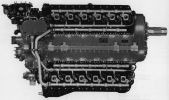 |
 |
| Lycoming XH-2470-1 | ||
The Navy had a development contract for a liquid-cooled 24-cylinder H-type engine (XH-2470) with a 5.250" (133.35 mm) bore, 4.750" (120.65 mm) stroke displacing 2,467.82 in³ (40.440 l) with a 2,000 hp at 3,100 rpm normal rating and 2,400 hp at 3,400 hp military rating. However, consideration had tentatively been given for reduction of the military rating to 2,200 hp.
After about 17 hours running at about 50% power, the full-scale engine experienced main bearing failure, which was blamed on insufficient bearing clearance. The engine was reassembled with new copper-lined bearings with increased clearance and operated at about 50% power for about 8 hours. Teardown inspection revealed that the engine was in generally good condition, although one main bearing showed evidence of a poor bond in a 1/4" diameter area and some bearings showed evidence of distress due to crankshaft deflection. Lycoming engineers thought this could be corrected by slightly relieving about a quarter of the bearing width on each side, similar to a practice used by Allison. Parts for three complete engines had been purchased, so Navy thought the test program could be expedited in the event of failures. The Navy contract envisioned progress through test running, followed by development of a two-stage supercharger drive and two-speed propeller drive so this XH-2470 engine could be used a replacement for the P&WA X-1800 in installations such as the Vultee XP-54 that required these features. However, the XP-54 could be flown with the two-speed supercharger. A total of 20 hours had been accumulated on the basic engine. The two-speed supercharger drive components were in the shop schedule for 1 Dec 1940 completion. Contemplated ratios were 1:7 and 1:9. The two-speed propeller drive was in design with completion expected in about nine months. The coaxial propeller drive was in preliminary design with completion indefinite. Only preliminary survey work had been done on the two-stage supercharger.
The existing reduction gear was a 4-pitch pinion with a 5" (127.00 mm) pitch diameter. The driven gear had a 16.25" (412.75 mm) diameter and was 3" (76.2 mm) wide. The reduction ratio was 3.25:1, but 2.8:1 was also available. The pinion was nitralloy while the gear was carburized. The 4-pitch gears looked very good after the limited running. Other gears of 5-pitch and 7-pitch were also available.
The then-current supercharger impeller diameter was 10.5" (266.70 mm) with a 1:7.9 drive ratio. Spring leaf couplings at each crankshaft's rear isolated crankshaft vibration from the supercharger drive. Torsional records had not yet been taken but were planned during the test program. A 12" (304.8 mm) impeller was also being considered.
The cylinders were practically identical to the O-1230 cylinders except that the XH-2470 application included a fuel injection boss and added coolant passages near the exhaust port. The nitralloy piston rings appeared to be in excellent condition after the running thus far, although some breakage at assembly had been encountered. The inspectors thought the ring depth was excessive.
Pratt & Whitney Aircraft
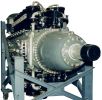 |
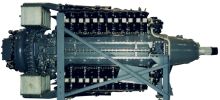 |
 |
| P&WA XH-3130 (H-3730) | ||
The inspectors spoke with P&WA Chief Engineer, Leonard S. Hobbs, and Chief Designer Andy V. Wilgoos about the X-1800 and H-3130. Hobbs commented that the ongoing production program was taxing P&WA engineering to the utmost. Ford Motor Company's R-2800 production program and more powerful 2,000 and 2,100 hp R-2800 versions all required considerable engineering support. In addition to production ramp-up, the R-2800 and R-2000 engine types required cylinder modifications to accommodate reverse-flow cooling, propeller shaft extensions, dual-rotation propeller drives, and related modifications for certain aircraft installations.
Irrespective of Hobbs' objections, the X-1800 test program was well ahead of the contract schedule. However, P&WA proposed to cancel the X-1800 immediately and the Navy's H-3730 as soon as the first engine was delivered. The inspectors pointed out that if the X-1800 program was terminated, the Lycoming XH-2470 or WAC R-2160 could be substituted. Also, Continental had proposed an XH-2860 that looked attractive and Chrysler was working on a 16-cylinder inverted V. However, loss of the H-3130 program would be a major setback because it was the only engine with the potential to reach 3,000 hp. Hence, the inspectors suggested that if the X-1800 project was dropped that accelerated H-3130 development should be undertaken, as it was the only viable engine for very large, long-range bombers.
The inspectors suggested turning the H-3130 design over to another company; Ford and Chrysler were mentioned. Wilgoos objected to this because it would be necessary to sell the new company on a product for which it had no interest, not to mention, a large engineering staff would be required for the transition.
Ranger Engineering Corporation
 |
| Ranger X-1850 |
Discussions with Messers Fairchild, Ward and Gregory about Ranger inverted V-12 engines, along with a proposed H-24 engine revealed that the inverted V-12 had a 520 hp takeoff rating, which might be used in advanced trainer applications. In production quantities, this engine might be cheaper than P&WA Wasp Jrs. Ranger believed that transition from an advanced training airplane using inverted V-12 engine to service pursuit aircraft, such as the Curtiss P-40, would be less difficult for a flying cadet than if the transition were made from present radial-engine advanced trainers, such as the North American AT-6.
The 24-cylinder H-type air-cooled engine was interesting from the development viewpoint. Navy was interested in a light, high-performance carrier-based airplane. Such an engine presented streamlined liquid-cooled characteristics without coolant radiator requirements. Its frontal area exposed to head-on gunfire was less than air-cooled radials of comparable power.
Ranger Model H-1200 Maximum Takeoff Rating = 1,200 bhp at 4,200 ± 200 hp at sea level; Normal Rating = 1,100 hp at 4,000 ± 200 rpm, sea level to 5,000 ft; Bore = 4.000" (101.60 mm); Stroke = 4.000" (101.60 mm); Displacement = 1,206.37 in³ (19.769 l); Compression Ratio = 7.0:1; Propeller Gear Ratio = 3.0:1; Length = 78.75" (1,924.05 mm); Width = 26.125" (663.575 mm); Height = 37.375" (974.725 mm); Enveloping Front Circle = 40.250" (1,022.35 mm); Weight = 1,220 lb (553.4 kg). This engine was eventually implemented as the X-1850.
The Inspectors suggested that the Ranger chief engineer prepare additional data covering pressure drop across the engine cylinders for cooling, air scoop dimensions, oil radiator dimensions, oil BTU heat rejection, oil flow, and a two-stage supercharger design applicable to this engine. Such an engine (and engine installation) might be applicable to a light, high-performance interceptor and a highly maneuverable anti-tank attack aircraft.
Wright Aeronautical Corporation
A conference with WAC Mr. Taylor in connection with the 14-cylinder test engine as well as the full-scale 42 cylinder engine program. Four experimental 14-cylinder engine modules have been built. WAC engine No. 11760 was being used for basic test work. WAC engine No. 11761 was being used for development tests under Contract No. 12632. The other two engines had not been assembled, as they are a parts source to keep Nos. 11760 and 11762 operating. The 50-hr endurance tests on the 14-cylinder test engines had been completed; the 150-hr model tests were scheduled for early November. The first full-scale 42-cylinder engine was being assembled, including the front section, which included the reduction gearing as well as the rear section, which included the supercharger and accessory drives.
| ||||||||||||||||||||||||||||||||||||||||||||||||||||||||||||
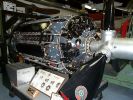 |
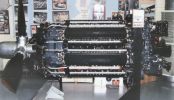 |
| WAC XR-2160 Tornado | |
The delivery schedules for the first three engines appeared to be reasonably satisfactory; however the delivery dates for the Hughes project engines were not. It was necessary to pressure WAC for satisfactory deliveries of the entire development project.
It appeared that first WAC company priority was given to production projects; unless the Division made every effort to accelerate the program it was obvious that sufficient man and machine time would not be taken from production to keep the experimental program functioning. In order to assure a reasonable Hughes project acceleration, it was necessary to either advise WAC of Air Corps interest in the Hughes or to add these two engines to the Army procurement program. With the present high production priority it was difficult to obtain any priority on what appears to be a purely commercial undertaking [Author: Pure Wright Aeronautical standard operating procedure].
In order to accelerate Tornado development, it was desirable to procure additional engine for an additional airplane installation plus spares for both the Hughes project and the new project. [Author: What a wonderful incentive for WAC to continue stonewalling Tornado production!]
At first glance, the 42-cylinder engine appears to be terrifically complicated with a far greater parts count than would be considered desirable in an Air Corps engine. From a production viewpoint, the complications were not so serious. For example, all cylinders were identical; three identical very short and simple crankshafts of rugged design; same is true of the Master and link rod assemblies. [Author: This is again an apology for the Air Corps having swallowed WAC's ongoing R-2160 "features." None of these "features" would contribute to a viable Air Corps engine.
Conclusions
Recommendations
10 Mar 1941
A cross-reference card reflects that the Wright Field Experimental Engineering Chief informed the Wright Field Production Engineering Chief that WAC was considering abandoning the 9HB and R-2170 engines to permit development of larger, more powerful types. The Experimental Engineering Chief recommended provisions where experimental and semi-production development stages could be accomplished without impacting mass production, and that such a new shop should place first priority on experimental and development construction. [Note: WAC never had a strong in-house experimental shop. The company preferred to let the Government finance new development and used outside vendors for experimental casting, forging and machining. This philosophy slowed the devleopment cycle and introduced errors.]
From 28 Aug through 18 Nov 1942, civilian employee Benedict J. Mankus released the first in a series of very brief contract status reports intended for the Inspection Section Chief. These outlined progress at the General Electric West Lynn, Massachusetts facility on XEG, XE-1, XCM, XEM and Type C turbosuperchargers, turbosupercharger components, and turbosupercharger testing, as well as two-stage cabin superchargers.
21 Aug 1942
Col F.O. Carroll sent an Inter-Office Memorandum to the Chief of Staff, Army Air Forces MatCmd in Washington, DC, reporting on the status of important engine developments. What a difference the two years since the Inspectors' report have made; the U.S. Army Air Corps has become the U.S. Army Air Forces (USAAF), P&WA has managed to extricate itself from the H-3130 and has substituted the air-cooled X-Wasp (R-4360), and WAC was still plodding along with XR-2160 and R-3350 development (all the time lying about both engines' status.<ol>
The Allison V-3420 had passed a 150-hr type test at 2,300 hp, but when subjected to a model test at 2,600 hp ran into undpecified difficulties, leading to a redesign. Development tests at 2,800 hp were ongoing at the Allison plant, but these had identified still more weaknesses that were being corrected by design changes.
The P&WA X-Wasp (R-4360) design had been subjected to 2,125 operating hours at the P&WA plant and was progressing satisfactorily. A type test had been started preliminary to submitting the engine to the Navy for official Government test. The first Army engine was to be delivered in January 1945 for ground test airplane installation.
The WAC XR-2160 reported "normal" progress, having accumulateed 803 hours 52 minutes of endurance running. Progress had been retarded by a higher priority on R-3350 development. [Note: This engine would ultimately be abandoned without every making the promised power, passing a type test or flying.]
The WAC R-3350-13 150-hr model test had been completed at the WAC plant, but the reduction gear was not satisfactory. WAC and the USAAF had decided the engine was safe to fly for at least 100 hours in XB-29 and XB-32 test aircraft. The first engine was to be delivered to the USAAF in January 1943. [Note: It would be the middle of 1944 before the R-3350 reduction gear, cooling and vibration problems would finally be addressed by retrofit kits supplied to 81 unfinished B-29s that had been produced in Wichita but were languishing in repair depots without engines. Depot personnel had to work outside in horrible Kansas winter conditions to install reworked R-3350 engines. Despite the rework, service R-3350s continued to overheat, exhibit poor mixture distrubution, catch fire, and generally cause the B-29 to have the highest loss rate of any WWII heavy bomber. After WWII, the Navy finally paid for a nearly complete redesign, which finally fixed all the design problems.]
22 Jan 1943
Assistant Chief of Staff Brig Gen B.E. Chidlaw, at the request of the British Air Commission, released a summary of development and flight time for important experimental engines then under development.
| Engine | Multi-Cylinder Time (hours) | Flight Time (hours) |
|---|---|---|
| Allison V-1710-47 | 1,100 | 155 |
| Allison V-1710-57 | 10 | 10 |
| Allison V-1710-65 | 10 | 0 |
| Allison V-1710-69 | 0 | 0 |
| Allison V-1710-71 | 0 | 0 |
| Allison V-1710-75 | 65 | 10 |
| Allison V-1710-77 | 50 | 0 |
| Allison V-1710-89 | 200 | 80 |
| Allison V-3420-5 | 0 | 0 |
| Allison V-3420-7 | 0 | 0 |
| Allison V-3420-11 | 400 | 0 |
| Allison V-3420-13 | 400 | 0 |
| Allison V-3420-15 | 0 | 0 |
| Chrysler XI-2220-1 | 78 | 0 |
| Chrysler XI-2220-3 | 0 | 0 |
| Chrysler XI-2220- | 0 | 0 |
| Continental IV-1430-19 | 7,700 V-2 and 5,605 V-12 operation. No breakdown available for individual models. | |
| Continental IV-1430-3 | ||
| Continental IV-1430-5 | ||
| Continental IV-1430-7 | ||
| Continental IV-1430-9 | ||
| Continental IV-1430-13 | ||
| Lycoming XH-2470-1 | BuAer engine, no data available. | |
| P&WA R-2800-27 | Time unavailable, model test not completed. | |
| P&WA R-2800-37 | ||
| P&WA R-2800-45 | ||
| P&WA R-4360-3 | 5,000 single cylinder, 5,000 multi | |
| P&WA R-4360-5 | ||
| P&WA R-4360-7 | ||
| Ranger IV-779-5 | BuAer Engine | 30,000 |
| Ranger IV-779-7 | ||
| Studebaker XH-9350 | 1.5 single-cylinder | |
| WAC R-2160-1 | 2,160 | 0 |
| WAC R-2160-3 | ||
| WAC R-2160-5 | ||
| WAC R-3350-7 | 5,700 | 0 |
| WAC R-3350-9 | Breakdown | Unavailable |
| WAC R-3350-19 | ||
| WAC R-4090-1 | 28 | 0 |
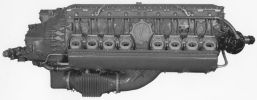 |
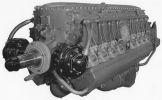 |
| Chrysler XI-2220 | |
By 1944, development of U.S. engines that would significantly contribute to WWII was essentially complete. The remaining documents in this collection primarily address aircraft/engine integration details and hints of new gas turbine power plants as the War's prosecution started to turn in favor of the Allies.
Starting 6 Oct 1944, 2nd Lt Burtos S. Garrell issued a series of weekly engine development reports about the Chrysler XI-2200 V-16. These reports, covering single, twin and V-16 engine tests, continued through 17 Nov 1944. Their content has been covered elsewhere and are not included here other that to establish that the XI-2220 was also part of the overall development landscape.
13 Nov 1944
There were also numerous sensors under development, including torquemeters, detonation indicators, along with Curtiss XP-55, Lockheed XP-58, Douglas B-19, Curtiss XP-40Q flight testing, and Allison V-1710/V-3420 installation in marine applications.
On 27 Mar 1946, Brig Gen L.C. Cragie estimated the engine preliminary development and low-volume production program would require about $5.0 M during FY 1947; Washington allocated $2.5 M, continuing the age-old practice of under funding aircraft power plant development.
3 Mar 1945
Power Plant Laboratory civilian employee Ford L. Prescott sent PPL Col D.J. Kerin a summary of military engines then under development.
The Studebaker XH-9350 engine was intended for monocoque-engine-mount pusher installation with provision for mounting the engine and 2-speed dual-rotation propeller reduction gearbox (a total of three units) between wing spars. This engine's single-cylinder performance was satisfactory. A new angle-valve cylinder design was expected to be complete in May 1945 with development continuing through December 1945. The 24-cylinder engine preliminary design was expected in September 1945, drawings July 1946 or later, with fabrication between January and September 1946. Test facilities were being designed.
The Lycoming XR-7755 was intended for tractor installation ahead of the wing spar; engine mount weight was 600 lb. Single-cylinder performance was satisfactory, a new cylinder design with no radical changes was being tested with completion by May 1945. The 36-cylinder design was practically complete during February 1945; drawings were to be available by March 1945. Full-scale test facilities were being installed.
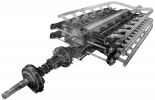 |
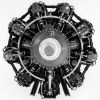 |
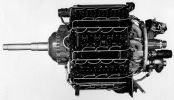 |
| Studebaker XH-9350 (NARA, William Pearce) |
Lycoming XR-7755-3 (NARA) |
|
Prescott suggested that potential applications for these engines should be thoroughly studied before the Government acquired additional test equipment. Studebaker executives had stated the total number of 5,000 hp class engines was insufficient to involve more than a single vendor. The Lycoming engine would be ready for installation at least 1.5 years before the Studebaker engine, which had turned to be extremely bulky, heavy and difficult to install, largely because of the massive components from which it was made. These included two crankshafts, combining gear and crankcase. The large separate cylinders in conjunction with the shafts and couplings connecting the three subassemblies, were fundamentally responsible for the engine's high weight, which amounted to about 1,000 lb per engine. While Studebaker testing facilities were still being designed, Lycoming facilities were being installed.
Prescott provided the following development cost data:
| |||||||||||||||||||||||||||||||||||||||||||||||||||||||||||||||
Prescott opined, "In view of the death sentence imposed on the entire Continental project, and the unfavorable pictures presented by the Chrysler project, together with the strong probability that the Chrysler engine will not find a place in the fighter program, it is recommended that the Chrysler project be closed as soon as possible with an audit of all costs, to determine whether excessive charges have been made for material or services." It had been impossible to get any detailed Chrysler cost data. Even costs for the large items had been unavailable. What costs Chrysler had furnished were incomplete or estimates, in spite of careful cost records undoubtedly maintained by the company. Conversely, Continental had always furnished full cost data and cooperated in every way with the ATSC.
In view of the 1.5 – 2.0 years required by Studebaker beyond probable delivery of the Lycoming engine, Prescott recommended that the XH-9350 cost program with test facilities be stopped, and that then-current work be limited to single-cylinder studies and the production of three complete blueprint sets for the 24-cylinder engine.
| Manufacturer | Studebaker | Lycoming | Chrysler | Continental |
| Designation | XH-9350 | XR-7755 | XI-2220 | IV-1430 |
| Configuration | H-24, separate cylinder | R-36 (4x9, inline banks) | Inverted V-16 | Inverted V-12 |
| Bore x Stroke | 8.000" x 7.750" | 6.375" x 6.750" | 5.800" x 5.250" | 5.500" x 5.000" |
| Takeoff Rating, hp @ rpm | 5,000 @ 2,200 | 5,000 @ 2,600 | 2,300 @ 3,400 | 1,700 @ 3,000 rpm |
| Normal Rating, hp @ rpm | 4,000 @ 2,000 | 4,000 @ 2,300 | 2,100 @ 3,400 WER | |
| Cruise Rating, hp | 1,000–3,000 | 1.000 – 3,000 | 1,175 @ 2,600 | 960 @ 2,800 |
| Estimated csfc | 0.37 | 0.37 | 0.51 | |
| Compression Ratio | 8.0:1 | 8.5:1 | 6.25:1 | 6.5:1 |
| Supercharging | Turbo only | Geared and Turbo | Geared and Turbo | Geared and Turbo |
| Prop Reduction Ratio | 3.4014 & 2.3981:1 | 4.0650 & 2.8249:1 | 2.1739:1 | 2.5974:1 |
| Propeller Shaft | 60L-80 | 60L-80 | SAE No. 50 or 60 | SAE No. 50 |
| Length | 240" | 125" | 120" | 64.063" |
| Width (Diameter) | 105" | (62.75") | 34" | 30.625" |
| Height | 40" | 44" | 40.375" | |
| Weight | 7,080 lb | 6,033 lb | 2,350 lb | 1,445 lb |
| hp/in³ | 0.535 | 0.644 | 1.036 | 1.19 |
| hp/lb | 0.707 | 0.828 | 0.98 | 1.175 |
| lb/in³ | 0.757 | 0.778 | 1.06 | 1.01 |
| All engines were glycol cooled and had two valves per cylinder. | ||||